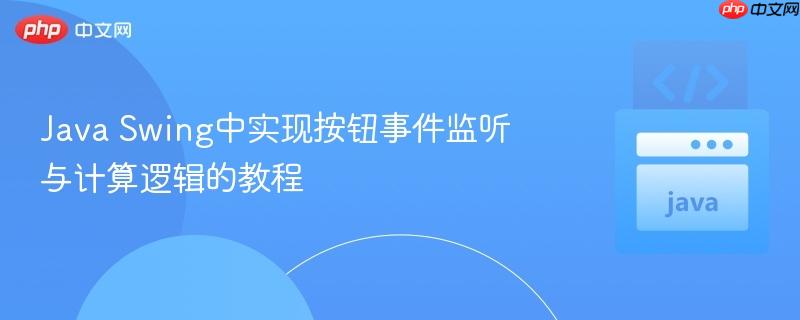
在java swing中构建交互式图形用户界面(gui)时,响应用户操作(如按钮点击)是核心功能之一。actionlistener接口是处理这类事件的标准方法。本教程将通过一个简单的计算器示例,详细讲解如何为一个包含多个按钮的界面实现统一的事件监听,并正确处理用户输入和计算逻辑。
在深入代码之前,我们先回顾几个关键概念:
首先,我们需要构建一个基本的Swing界面,包含用于输入操作数的JTextField、显示结果的JTextField(或JLabel)以及执行不同运算的JButton。
import java.awt.*;
import java.awt.event.ActionEvent;
import java.awt.event.ActionListener;
import javax.swing.*;
public class SimpleCalculator extends JFrame implements ActionListener {
// 声明GUI组件
private JButton add, subtract, multiply, divide;
private JLabel operand1Label, operand2Label, outputLabel;
private JTextField op1Field, op2Field, resultField;
// 构造函数:初始化GUI
public SimpleCalculator() {
// 设置窗口属性
setTitle("简易计算器");
setSize(300, 250);
setDefaultCloseOperation(JFrame.EXIT_ON_CLOSE);
setLayout(new FlowLayout()); // 使用流式布局
// 初始化标签和文本字段
operand1Label = new JLabel("操作数 1:");
op1Field = new JTextField(10);
operand2Label = new JLabel("操作数 2:");
op2Field = new JTextField(10);
outputLabel = new JLabel("结果:");
resultField = new JTextField(15);
resultField.setEditable(false); // 结果字段不可编辑
// 初始化按钮并添加ActionListener
add = new JButton("加");
add.addActionListener(this); // 将当前JFrame实例注册为监听器
subtract = new JButton("减");
subtract.addActionListener(this);
multiply = new JButton("乘");
multiply.addActionListener(this);
divide = new JButton("除");
divide.addActionListener(this);
// 将组件添加到窗口
add(operand1Label);
add(op1Field);
add(operand2Label);
add(op2Field);
add(add);
add(subtract);
add(multiply);
add(divide);
add(outputLabel);
add(resultField);
// 显示窗口
setVisible(true);
}
public static void main(String[] args) {
// 在事件调度线程中创建GUI
SwingUtilities.invokeLater(SimpleCalculator::new);
}
}注意事项:
actionPerformed方法是处理所有注册事件的核心。在这里,我们需要判断是哪个按钮被点击,然后获取用户输入,执行计算,并更新结果。
立即学习“Java免费学习笔记(深入)”;
@Override
public void actionPerformed(ActionEvent ae) {
try {
// 获取操作数,必须在事件触发时获取,而不是在构造函数中
int num1 = Integer.parseInt(op1Field.getText());
int num2 = Integer.parseInt(op2Field.getText());
int calculationResult = 0; // 用于存储计算结果
// 根据事件源(哪个按钮被点击)执行相应操作
if (ae.getSource() == add) {
calculationResult = num1 + num2;
resultField.setText(String.format("%d + %d = %d", num1, num2, calculationResult));
} else if (ae.getSource() == subtract) {
calculationResult = num1 - num2;
resultField.setText(String.format("%d - %d = %d", num1, num2, calculationResult));
} else if (ae.getSource() == multiply) {
calculationResult = num1 * num2;
resultField.setText(String.format("%d * %d = %d", num1, num2, calculationResult));
} else if (ae.getSource() == divide) {
if (num2 == 0) {
resultField.setText("错误: 除数不能为零");
return; // 避免执行后续操作
}
calculationResult = num1 / num2;
resultField.setText(String.format("%d / %d = %d", num1, num2, calculationResult));
}
} catch (NumberFormatException ex) {
// 处理用户输入非数字的情况
resultField.setText("错误: 请输入有效的整数");
System.err.println("输入格式错误: " + ex.getMessage());
} catch (Exception ex) {
// 捕获其他未知异常
resultField.setText("发生未知错误");
System.err.println("未知错误: " + ex.getMessage());
}
}关键点解析:
将上述GUI设置和actionPerformed方法整合,得到一个功能完整的简易计算器。
import java.awt.*;
import java.awt.event.ActionEvent;
import java.awt.event.ActionListener;
import javax.swing.*;
public class SimpleCalculator extends JFrame implements ActionListener {
private JButton add, subtract, multiply, divide;
private JLabel operand1Label, operand2Label, outputLabel;
private JTextField op1Field, op2Field, resultField;
public SimpleCalculator() {
setTitle("简易计算器");
setSize(300, 250);
setDefaultCloseOperation(JFrame.EXIT_ON_CLOSE);
setLayout(new FlowLayout());
operand1Label = new JLabel("操作数 1:");
op1Field = new JTextField(10);
operand2Label = new JLabel("操作数 2:");
op2Field = new JTextField(10);
outputLabel = new JLabel("结果:");
resultField = new JTextField(15);
resultField.setEditable(false);
add = new JButton("加");
add.addActionListener(this);
subtract = new JButton("减");
subtract.addActionListener(this);
multiply = new JButton("乘");
multiply.addActionListener(this);
divide = new JButton("除");
divide.addActionListener(this);
add(operand1Label);
add(op1Field);
add(operand2Label);
add(op2Field);
add(add);
add(subtract);
add(multiply);
add(divide);
add(outputLabel);
add(resultField);
setVisible(true);
}
@Override
public void actionPerformed(ActionEvent ae) {
try {
int num1 = Integer.parseInt(op1Field.getText());
int num2 = Integer.parseInt(op2Field.getText());
int calculationResult;
if (ae.getSource() == add) {
calculationResult = num1 + num2;
resultField.setText(String.format("%d + %d = %d", num1, num2, calculationResult));
} else if (ae.getSource() == subtract) {
calculationResult = num1 - num2;
resultField.setText(String.format("%d - %d = %d", num1, num2, calculationResult));
} else if (ae.getSource() == multiply) {
calculationResult = num1 * num2;
resultField.setText(String.format("%d * %d = %d", num1, num2, calculationResult));
} else if (ae.getSource() == divide) {
if (num2 == 0) {
resultField.setText("错误: 除数不能为零");
return;
}
calculationResult = num1 / num2;
resultField.setText(String.format("%d / %d = %d", num1, num2, calculationResult));
}
} catch (NumberFormatException ex) {
resultField.setText("错误: 请输入有效的整数");
System.err.println("输入格式错误: " + ex.getMessage());
} catch (Exception ex) {
resultField.setText("发生未知错误");
System.err.println("未知错误: " + ex.getMessage());
}
}
public static void main(String[] args) {
SwingUtilities.invokeLater(SimpleCalculator::new);
}
}通过遵循这些原则和实践,开发者可以构建出响应灵敏、健壮且用户友好的Java Swing应用程序。
以上就是Java Swing中实现按钮事件监听与计算逻辑的教程的详细内容,更多请关注php中文网其它相关文章!

Windows激活工具是正版认证的激活工具,永久激活,一键解决windows许可证即将过期。可激活win7系统、win8.1系统、win10系统、win11系统。下载后先看完视频激活教程,再进行操作,100%激活成功。

Copyright 2014-2025 https://www.php.cn/ All Rights Reserved | php.cn | 湘ICP备2023035733号